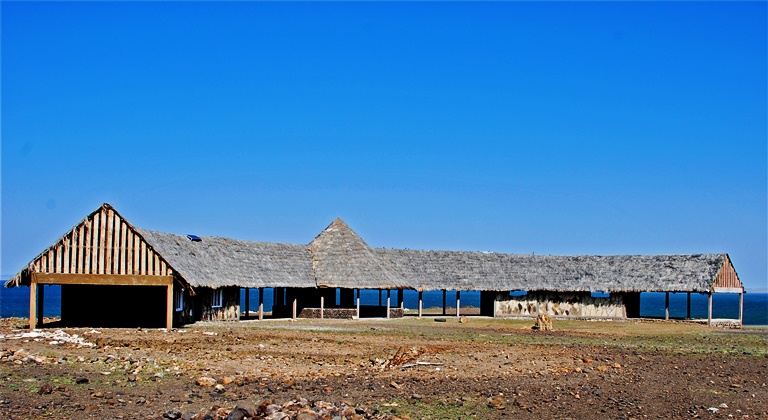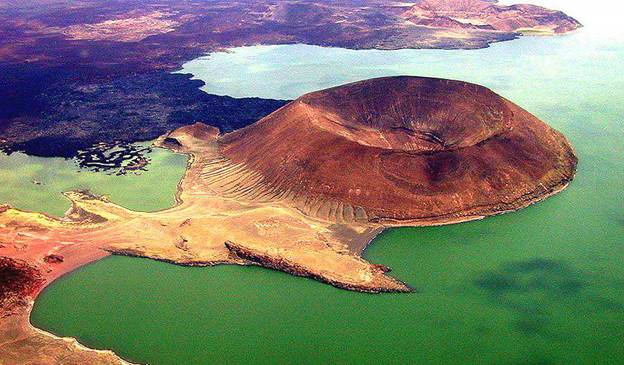Marsabit County is located in the more arid northern part of Kenya. Regardless of the climate, it’s one of the richest counties in natural minerals. Its unique topography that features volcanoes, crater lakes, and wildlife makes it an attractive destination for adventure and nature enthusiasts throughout the year. Here’s a list of the top 10 places to visit in Marsabit County.
1) Marsabit National Park and Reserve

The park covers an area of 1,554 kilometers squared and hosts some of the most unique natural attractions including; Lake Paradise, 3 craters, dense forests, and the singing wells. It’s home to huge-tusked elephants, gazelles, buffalos, a diverse birdlife, and reptiles. It’s the ideal destination for game drives, bird watching, and camel rides.
2) Loiyangalani Desert Museum

Loiyangalani Desert Museum was opened in 2008 and is the only desert museum in East and Central Africa. It sits on top of a hill with a stunning backdrop of Lake Turkana. The museum was established to preserve, communicate, and exhibit the cultures of the communities in Marsabit.
3) Mt. Kulal

Mt. Kula is an eroded-down volcano located east of Lake Turkana, approximately 50 km from Loiyangalani. At a height of 2,293 km, Mt. Kulal dominated Lake Turkana’s eastern horizon. Its densely forested sides offer an exciting hiking trail. From the summit, you get a spectacular view of Lake Victoria.
4) El Molo Villages and Shrines

The El Molo are a tiny tribal community, the smallest tribe in Kenya. The village, found near Lake Turkana, is made up of uniquely woven huts in close proximity to each other. Their shrines are found on Lorian Island. There are four shrines, representing the 4 clans of the El Molo people. Interacting with, and learning about the culture of the El Molo is a once-in-a-lifetime experience.
5) Mt. Marsabit

Mt. Marsabit is a 6,300 kilometers squared basalt shield volcano found near Marsabit Town. It’s covered by a dense forest that makes up Marsabit National Park and Reserve and is home to a variety of wildlife like; huge-tusked elephants, buffalos, gazelles, and diverse birdlife. The foot of the mountain has the most beautiful crater lakes. Mt. Marsabit is a destination in a league of its own.
6) Chalbi Desert

The Chalbi Desert covers an area of about 100,000 kilometers squared and is one of the hottest and most arid places in Kenya. The desert is believed to have been a lake that dried up a thousand years ago. This is related to its name, Chalbi, which means ‘bare and salty’ in the Gabra language. While there, you can take a desert ride in vehicles and quad bikes and see the sceneries and tranquil oases. Or you can explore the desert on the back of camels as the locals do. It’s quite the experience.
7) Kalacha Camp and Rock Art

Kalacha Camp is found on the banks of an oasis in the Chalbi Desert. The camp offers accommodation in four rustic bandas. There’s also a pool which is a refreshing escape from the desert heat. While staying there, you can plan a visit to the Kalacha Rock Art, in North Horr. It features ancient rock engravings dating back over 1000 years and is associated with rain-making rituals.
8) Losai National Reserve

Losai National Reserve is a wild, semi-desert animal reserve. The reserve’s topography features rocky hills, plains, and river woodlands on the banks of seasonal rivers. It’s a place of scenic beauty but little wildlife including; pythons, cobras, bees, scorpions, and battles. Sadly, all the large wildlife was poached. This has affected tourism in Losai National Reserve.
9) Koobi Fora Museum and Site

Koobi Fora Museum and Site is a world heritage site believe to be the cradle of mankind. Research work on the site began in 1968 and it’s where Dr. Richard Leakey discovered the first Australopithecus skull. The site comprises approximately 700 square miles of sediments showing a continuous sequence of deposition from a million to 5 million years ago.
10) South Island National Park

South Island National Park is on an island that’s covered from end to end with volcanic ash. It’s home to little wildlife including; hippos, bats, and the world’s largest Nile crocodile population. It’s also abundant in birdlife including 34 species of European migrants most spectacularly viewed as they return home between March and May. But that’s not the most interesting part yet. This is; South Island’s luminous vents glow every night and this has inspired numerous tales of ghosts and evil spirits on the island.
I am a charismatic 23-year-old student at the University of Nairobi. I enjoy traveling be it planned or impromptu. I also enjoy partying. I'll be there with a drink in my cup all through the night, chasing the sun. Life's too short not to choose the fast lane. Carpe diem!


